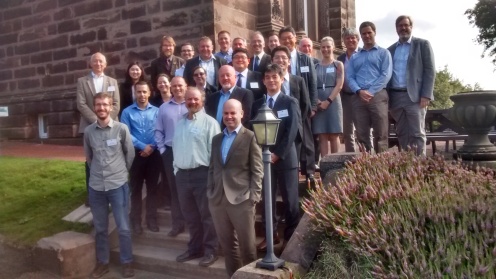Space Traffic Management Joins the Edinburgh Fringe.
Recently I participated in the second annual Space Traffic Management Workshop hosted by the University of Edinburgh, Science and Technology Facilities Council and Lockheed Martin. The workshop brought together invited participants from the academic, commercial and government sectors, including the military, with expertise across a range of domains (not solely space) to discuss the potential future requirements for space traffic management. As noted at the inaugural workshop, more and more satellites are launched each year into orbits populated with an increasing quantity of debris and it has become ever more apparent that there is a requirement to manage space traffic more closely. However, this needs to be achieved without hindering the innovation and inspiration inherent to the space industry. A hindrance many feel is inevitable if/when regulation is applied. Furthermore, space traffic management is a global problem that requires input from a range of disciplines, thus coordination along with collaboration will also be the key to its success but this is inherently more difficult to achieve quickly, and effectively, when large numbers of international participants are involved. Ultimately, I believe we are running out of time as, not only are we approaching the ‘cliff edge’ but the edge is rapidly approaching us.
Last years’ event had considered a number of space traffic management challenges impacting the space operations community including policy, technology and infrastructure issues. This years’ event, held at the Royal Observatory Edinburgh from 29 – 31 August, further explored what the future space traffic management capability may look like, including what and how it would manage ‘traffic’, utilitising a series of scenario based exercises. Its aim ultimately to develop ‘strands’ of research to significantly contribute to the growing dialogue and development surrounding space traffic management.

The view over Edinburgh from the Royal Observatory Edinburgh constantly threatened to distract participants.
This years’ experts were drawn from the UK, USA, Australia, Thailand and Japan with backgrounds spanning government, industry, military and academia. For me, it is the vast differences of experiences amongst the participants which enables the rich discussions that developed around the skeleton framework of the scenarios. Beginning with a brief introductory ‘round robin’ of participants before reviewing the conclusions of last years’ workshop, the participants were quickly ‘launched’ (pardon the pun) into the first scenario developed to answer the question: How would a future Space Traffic Management Centre be informed about an upcoming launch?
The initial discussions centred on the type of information that the ‘Space Traffic Management Centre’ might need to ensure positive tracking and identification; was there a need for a “Space Flight Plan”? A number of themes were explored including the type of information required, how that would be provided to the centre, and how could the information best support monitoring during the launch and deployment phases, particularly for multiple payloads. It was widely agreed that much of this information already exists but currently has to be ‘pulled’ from either the launch providers or satellite operators and there are neither the resource nor means to do so, at this time. Additionally, many owner operators and launch providers are not willing to share too much information on the grounds of commercial and/or national sensitivities; space is inherently ‘proprietary’. However, as was raised on a number of occasions during the event, Air Traffic Control (ATC) manages to get the information it needs to support flight safety so why can’t space traffic management? Will this become easier as space becomes more commercial? Typical of such workshops, the risk of disappearing down a labyrinth of ‘rabbit holes’ was ever present but rarely did the subject stray from supporting the key points of the discussion, and when it did the ‘rabbit hole’ proved purposeful.
The second and third scenarios explored the question of conjunctions and intentional close approaches respectively, and, what space traffic management would need to support ‘safety of flight’ or close proximity operations. Supporting safety of space operations must be a key pillar of any space traffic management system to assure future sustainable space operations. The major conundrum is how this can be provided under current rules and regulations, and if not what regulations are required? This is one of the many divergences when attempting to compare developed ATC to the development space traffic management. Although there are some commonalities current space operations are a long way from the days of developing terrestrial flight; for one space is established after almost 60 years of operation. Owner operators cannot be expected to provide ‘safety of flight’ as they can only guarantee access to data on their own objects and not to data on objects they may be at projected risk of collision from, especially if that object is debris; there is no accurate debris catalogue. Although Space Flight Plans would provide some information informing orbital propagation the current space surveillance data on low earth orbital objects predominantly resides with military systems and therefore we are faced with 2 major problems. Firstly, the military are neither resourced to provide space traffic management nor inclined to provide it; it is not a military responsibility. Secondly, while space surveillance sensors remain under military control it will always prove difficult to share the data/information they generate. This is not such a problem with the proliferation of commercial and academic surveillance sensors covering GEO but will persist until an adequate system of sensors exist for LEO; not only costly but also not a short-term endeavour.
Over the course of the 3 days policy and operational development presentations were also interwoven throughout the scenarios. These included an overview on the developments in the US Federal Aviation Authority potential role in US space traffic management, an update from Secure World Foundation, UN Space Traffic Management activities, NATO space support developments, and finally an impromptu introduction to the fledgling EU Space Surveillance and Tracking Framework.
It is abundantly clear that there is a lot of ongoing work to support ‘safety of flight’, resilient operations and to develop the concept of a ‘space traffic management’ system but we are still a long way from its employment…and that is not including the time it will take to put develop and implement the necessary rules and regulations to support such a system. From the scenario discussions, it became abundantly clear to me that we [national and global space communities] were a long way from even the early stages of a space traffic management system, although some nations were closer to leading than others. The workshop successfully identified a number of key elements to support such a system but the organisations and regulations are far from being prepared to implement the system and promoting responsible space operations has a long way to go before it is viable…even on a national enforcement scale. I got the impression that the appetite to provide data to operators was high but that for regulation and enforcement was low. Even if there were an appetite for regulation the systems currently don’t exist to effectively monitor and enforce.
Personally, I believe that unless someone takes the lead soon we will be too late to assure sustainable space. Although admirable, the idea of the main ‘players’ developing rules of the road for responsible actors to follow will take far too long to develop and implement. The evidence from recent events both in GEO and LEO is that operators, while attempting to act responsibly will still be faced with conflicting responsibilities whether to the customer, market or shareholder. Currently there is no one organisation able to monitor and enforce the any agreed rules and, if there were, where are the proven processes to implement them? Has anyone been taken to task for inappropriate actions in space? With the dawn of mega-constellations looming ever closer, non-traditional commercial companies and disruptive technologies threatening to both reduce the coast of, and increase the number of launches we are rapidly running out of time.
In conclusion this years workshop was extremely productive. A significant number of follow up projects have been identified to keep many of the participants busy over the coming months and a number of research themes were generated and will be circulated within academic circles for consideration. Not only do I look forward to continuing the collaborations over the next 12 months but also to the 2018 Space Traffic Management Workshop. Edinburgh is always a pleasure to visit, but to be able to visit such a great city with exalted company and participate in enlightening discussion…its a no brainer. I hope some of you may be able to join us next year.
Useful links:
1. “The case for a commercial/civil space traffic management capability” – Report from the 2016 Space Traffic Management Workshop. http://events.ph.ed.ac.uk/space-traffic/report
2. 2017 Space Traffic Management Workshop. http://events.ph.ed.ac.uk/space-traffic2
 Participants of the 2017 Space Traffic Management Workshop – Royal Observatory Edinburgh
Participants of the 2017 Space Traffic Management Workshop – Royal Observatory Edinburgh
Interesting post on the workshop. It is interesting that no one organisation appears to have taken ownership of this issue.
A lot has to do with the desire not to over regulate and that space is a ‘global common’. There are a number of treaties, proposed codes of conduct and national legislation such as the UK Space Act 1986 but not every nation has either ratified the 1967 Outer Space Treaty or enacted there own legislation. There are a number of bodies such as UN COPUOS and IADC but they develop ideas based on voluntary best practises. Over the next few years the US may develop space traffic management through the FAA or Dept of Transport and I believe there is a hope that “if we start others will follow”. By then it might be too late!
Air traffic management was considerably easier. Each aircraft was being flown by a human, whose life was in jeopardy in a collision. There were no random bits of untracked aircraft debris littering the skies to be avoided. Even the small aircraft without transponders were being tracked by primary radars and had radios on board. Changing airspace classifications, requiring altitude encoding transponders to operate within them, and the deployment of TCAS, has eliminated aircraft collisions. Space traffic management is considerably different. It’s more like ATC with people shooting bullets and missiles at the aircraft; some you can track, others you can’t, and you may be as likely to maneuver into one while dodging another.
Couldn’t agree with you more…although I’d say it’s less like those ‘shooting at you’ and more like ”shooting at ‘to whom it may concern’!
Agreed, however it depends on what orbit you’re operating from. When other operators are launching tens or hundreds of cubesats in or through your operating altitude, you might just get the feeling they’re shooting at you. This is the one case where ‘traffic management’ could be most effective, but how will we know when an orbital altitude is ‘full’, and who makes that determination?
Your absolutely right about the case for ‘traffic management’ but considering we do not have constant surveillance on the LEO orbits, as one example, it will be hard not only to predict when an altitude is full but also to implement any form of traffic management. First step is to develop a capable surveillance system that can provide the information needed to monitor and enforce any rules and regulations. And it needs to be a civil run system as traffic management is not the responsibility of Defence.